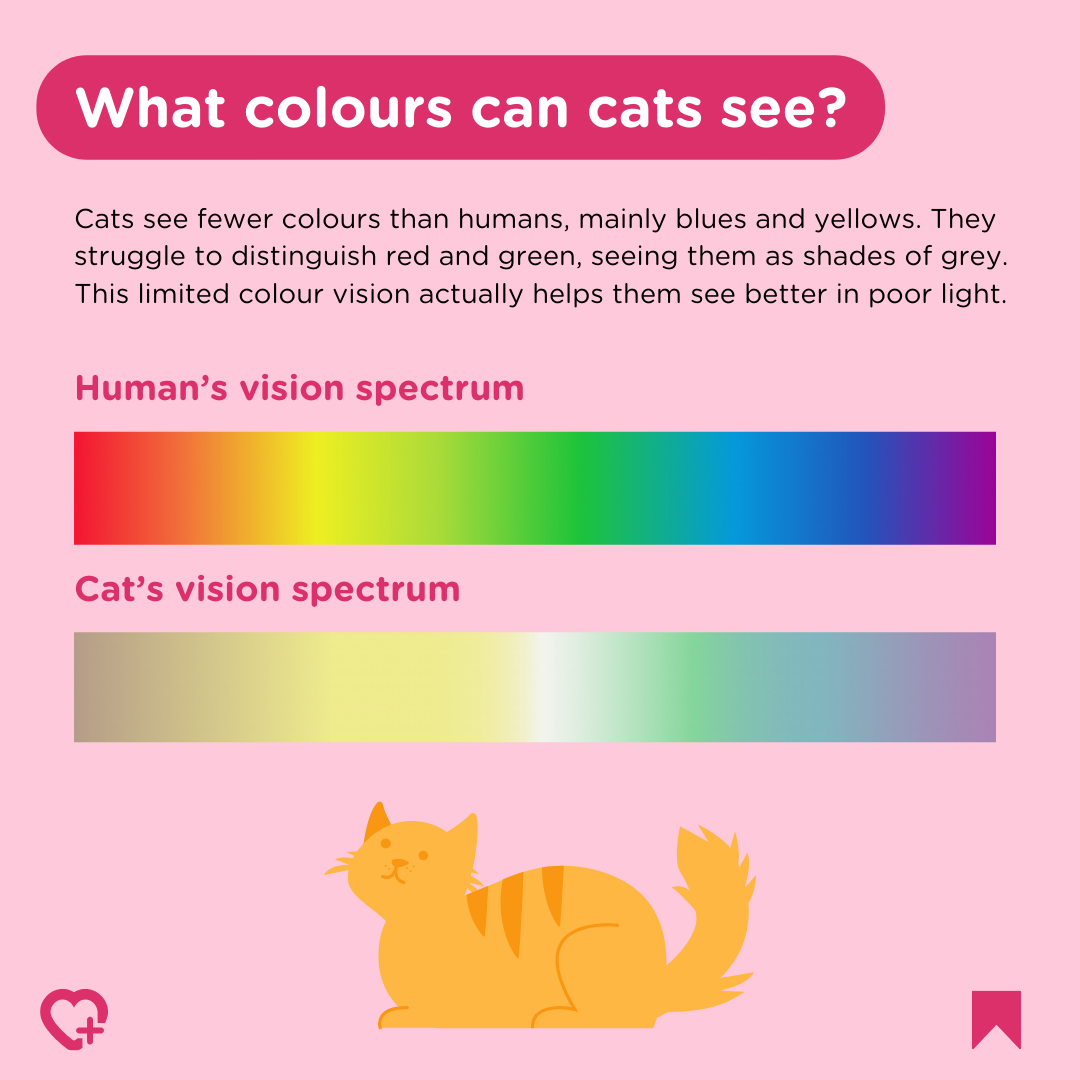What colours can cats see?
Cats can see colours, but not as many as humans. Contrary to the popular myth that cats see in only black and white, cats mainly see blues and yellows. This means colours like red and green don't stand out and appear more like shades of grey, similar to red-green colour blindness in humans. The upside of this simpler colour vision helps cats see better in poor light.
Understanding your cat's vision
Cats are predators that are most active during dawn and dusk, referred to as crepuscular activity. Their eyes are adapted to this, and they have two types of cone cells responsible for colour vision in bright light. This is different from humans, who have three types of cone cells in their eyes.
Cats also have a wider field of view — approximately 200 degrees, compared to humans' 180 degrees. This helps them detect slight movements, which is vital for their predatory behaviours. Their eyes are structured with a larger cornea and a unique, elliptical pupil, which allows more light to pass through, improving their night vision.
Behind your cat's retina lies a layer called the tapetum lucidum, which reflects light back through the retina. This increases the light available to the photoreceptors and contributes to their eerie eye glow in the dark. The downside for cats is their eyesight during the daytime or in brightly lit areas is not as sharp as that of humans. Their vision is a little blurry, and the colours aren't as vibrant.

Can cats see in the dark?
While humans have more cone cells, cats have six to eight times more rod cells, which gives them better night vision but less colour vision. Rod cells are special cells in the eyes (photoreceptors) that help cats, and people, see light and movement.
One of the most interesting aspects of a cat's vision is their ability to see in almost complete darkness. Cats can't see in absolute darkness — no mammal can — but their eyes are designed to ensure they're highly efficient at navigating and hunting in low-light conditions. This helps them make the most of the available light, particularly at dawn or dusk, whether from the moonlight or the faint glow of the rising sun.
On top of this, cats' pupils can also expand to a great extent to allow more light to enter the eye. In combination with the reflective properties of the tapetum lucidum, a layer of tissue that acts as a mirror to reflect light that passes through the retina back into the eye, this allows cats to see better in low-light environments.
How do cats see?
Cats are really good at seeing things move in low light. They are mid-sighted, which means objects need to be at a medium distance — no more than about 20 feet (6 metres) away — to be seen clearly.
They struggle to adjust their focus to see objects clearly at various distances. This might explain why, when a toy is placed directly in front of a cat, they sometimes struggle to see it clearly until it moves. Their sensitivity to movement, combined with their broader field of view and the ability to see in dim light, makes them excellent at detecting the slightest movements, which is really important for their survival as predators.
Practical advice for cat owners
You can make playtime more stimulating for your cat by choosing toys that are blue and yellow, the colours they see best. And since movement catches their eye most, toys that wiggle or flutter are also likely to be more engaging. It's also worth ensuring your home is safe and comfortable for your cat during nighttime.
Because cats can see so well in the dark, try using gentle lighting that won't hurt their eyes. Also, place their food and litter box where they can easily see them. This will help them navigate better and avoid confusion.
Academic studies into what colours can cats see
One study called neutral point testing of colour vision in the domestic cat investigated the type of colours cats can see. It found cats have two main colour sensors in their eyes for blue and yellow light, similar to people who are red-green colourblind. The research also looked for a third sensor that could allow cats to see as humans do but didn't find it. Cats were tested to see if they could tell different colours apart and struggled with greenish-blue colours. This shows they have what's called dichromatic vision, similar to humans with red-green colour blindness.
This old but groundbreaking study entitled cat colour vision: evidence for more than one cone process showed that cats can see colours better than people previously thought. In the past, it was believed that cats could only see well using one type of light-detecting cell in their eyes and another type that helps them see in low light. However, this research found that cats have more than one cell type for detecting colours, allowing them to distinguish colours like red from blue even in dim light. This suggests cats have a more complex system for seeing colours than previously understood.
Another piece of research entitled catalyst: seeing through the eyes of a cat explored the differences between human and cat vision through a simulated game. It adjusted colours and brightness to mimic what cats see, showing that cats have a narrower range of colours and superior night vision.
Need advice about your cat?
For expert advice on any cat health issues, get in touch with your local vet.
Find your nearest vet using our find a vet page, or speak to one of our vets online using our video vets service.



